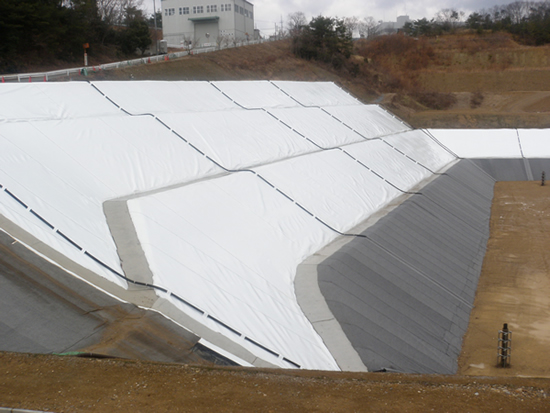Many infrastructure applications rely upon geosynthetic barriers. Over time, we’ve seen the specification of 40 or 60-mil black high-density polyethylene geomembranes become so common that black HDPE can feel almost like a commodity product. In part, this seems at odds with the critical containment these geomembranes provide. But, it is also in part a testimony to how the geosynthetics manufacturing industry has honed its standards to a point at which high quality in these long-used materials is the norm. Many manufacturers are active in the black HDPE geomembrane market.
So is this heralded material now a commodity? One thing that seems to suggest that is actually the tremendous R&D occurring in geomembranes. We are seeing a major move into white geomembranes, conductive geomembranes, materials engineered for niche applications (e.g., more extreme temperatures on a site). Paul Payeur of Solmax, one of the world’s largest gomembrane producers, joined us to discuss geomembrane trends and the continuing push towards reinvention.
Listen to “Resisting Commodity: The Continual Push Towards Reinvention in Geomembranes” on Spreaker.
The GeoTalk Podcast is released on Tuesdays. Recent episodes:
- September 12: How RUSLE2 Benefits Ag, Mining, Urban Design, and Other Sectors
- September 6:Enhanced Wicking Geotextile Emerges from an Engineering Challenge
- August 30: Improving Waterways and Coasts with Geosynthetics
- August 23: Creating Strong Environmental Programs
Subscribe on iTunes and in the Google Play store.
THE REINVENTION OF GEOMEMBRANE PERFORMANCE
How is the cycle of reinvention occurring?
“The way we achieve that these days is working with formulation, the resin,” says Payeur. “The resin people have been doing high-density and linear low density over the last 20 years. It’s all the same. They didn’t change. They didn’t improve. What we have to do internally is play with the formulation, the additives.”

On the innovation side, Solmax has worked to differentiate itself one application at a time. This has involved developing geomembranes for providing better service lives in specific environments, such as in high-temperature liquid containment. The company has created its Hot Liquid Rated Geomembranes and the Sekoia series, which the company believes is now the longest-lasting PE geomembrane liner available on the market.
Geomembranes can provide ordinary barrier service for hundreds of years in many buried applications, but full or partial UV exposure can greatly reduce their service lives. Here, manufacturers fine tune the additive package to try and protect the core stability of the geomembrane against depletion in aggressive conditions.
For elevated temperatures, Australia has proven to be a great place for investigation and reinvention. Sectors such as coal seam gas demand strong environmental containment in difficult UV conditions. Solmax’s Sekoia product line emerged from this challenge.

Mining is a growing market too, Payeur says, because mining routinely involves harsh conditions. The company has launched a Cost Reduction Program with the mining industry.
“What is your design?” he says. “What can we do for you? You’ve been using 60-mil HDPE over the last 20 years and it works. But, is there something else we can do? Is a 40 mil or LLDPE or 50 mil better? We do all the testing for them and say, ‘If there’s some saving we can give you….’”
Reinvention, it seems, is all part of a goal to increase education in the field and get geomembranes specified more precisely for their applications. Fine-tuning geosynthetics for those unique environments and getting the client base–engineers, facility operators, etc.–to understand how and why these variations are offered can only serve to enhance the long-term performance of these materials.
For more information on Solmax’s international operations, geosynthetics, and engineering expertise, visit www.solmax.com.











